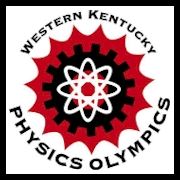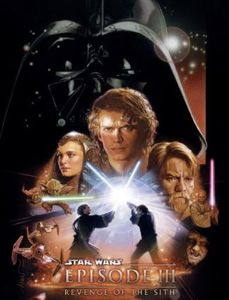2006 Physics Olympics
Star Wars
Overview
The WKU Department of Physics and Astronomy is inviting each high school in the region
to send one or more teams of four to compete in the 2006 Western Kentucky Physics
Olympics. This year’s event will be held Saturday, February 25 from 8:30 a.m. until about 2:00 p.m. in the Thompson Center, Central Wing on WKU’s Bowling Green campus.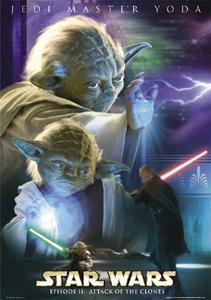
The theme for the 2006 Western Kentucky Physics Olympics is centered around "Star Wars". As has been the custom the event will consist of five different activities. The competition will commence with two activities that involve competitors arriving at the event ready to compete with devices they have designed, constructed, and tested. The Do-Ahead Project is titled "Han Solo in Carbonite", and the Plan-Ahead Project is called "Corellian Rocket Trials". The Calculation/Communication Challenge, requiring two members of the team to make a series of measurements and the other two members to use that data to calculate the desired result is still being planned. The final two events -- the On-the-Spot Activity, a mostly hands-on, impromptu challenge, and the Order-of-Magnitude Quiz, a brain teaser which asks contestants to quickly estimate answers for extreme situations -- will remain cloaked in secrecy until those events actually begin.
Event 1: Han Solo in Carbonite – The Do-Ahead Competition
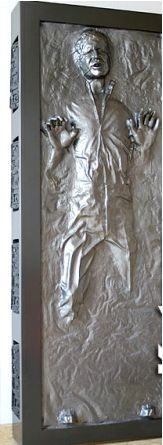
Han Solo enters the Star Wars storyline as a man on the run. The bounty hunter Boba Fett tracks Han (with Leia and Luke) to Lando Calrissian’s Cloud City on the gas giant planet Bespin, and sells the information to Darth Vader. Vader allows Boba Fett to take Han Solo, frozen in Carbonite, back to Jabba to receive an additional reward, claiming two bounties on the same man. Boba Fett doesn’t trust the carbon freezing process will not kill Han Solo, telling Vader: "What if he doesn't survive? He's worth a lot to me”. But the procedure goes ahead; Han Solo appears to survive; and Boba Fett delivers the carbonite block to Jabba the Hutt on Tatooine.
The object of this Do-Ahead Project is to first create the sugar glass and to encase the provided Han Solo figurine within. Next, each team must design a lightweight, low volume container that allows the encased figurine to arrive intact after being sent through the U.S. Mail from your local post office to this address:
Western Kentucky Physics Olympicsc/o Prof. Richard Gelderman
1906 College Heights Blvd
Bowling Green, KY 42101-1077
- Upon registration, each team will be sent a plastic Han Solo figurine and an aluminum
rectangular mini loaf pan to use as a mold for the “carbonite” block.
- The provided figurine is to be encased in “carbonite” (actually sugar glass) as per
the official Physics Olympics instructions.
- Seal your “carbonite” block, with Han encased within, into a ziplock-style plastic
bag.
- Design and fabricate the smallest container possible (smallest volume, smallest mass)
which will ensure the carbonite block’s safe passage via the U.S. Postal Service.
- Pack the carbonite block in its sealed ziplock-style plastic bag into your shipping
container, such that the judges can easily and safely remove the block.
- The size of the package must be smaller than 6 inches by 5 inches by 8 inches (such
that it can fit into a standard rural-style mailbox).
- Using the U.S. Postal Service, mail the package to the designated address for arrival
on or before Thursday, February 23rd, 2006. Late deliveries will not be judged.
- A judge will unpack and remove the carbonite block from all containers and wrappings.
A block that is damaged in the normal process of removing it from its containers/wrappings
will be judged as having failed to survive.
- Each team's score is calculated as the sum of points awarded for the “carbonite” block's
survival (0 to 50) and the product of volume (cm3) and mass (g) of the container (not including the carbonite block and ziplock-style
plastic bag. In case of tie scores, the amount of postage will be considered (less
is better). The team with the lowest score wins.
- All contestants will ensure that their entry works through the application of physics
principles and generally follows the spirit of the competition.
Event 2: Corellian Rocket Trials – The Plan-Ahead Competition
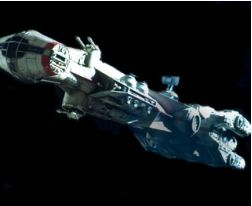 |
Corellia is one of the Core Worlds, home to the sector’s best pilots (it is Han Solo’s homeworld) and best shipwrights (the Millenium Falcon was built on Corellia, as was the Tantive IV, Princess Leia’s CR90 Corvette from the original, 1976, Star Wars movie). The Corellian Engineering Corporation supplies most of the freighters in use throughout the galaxy, as well as a number of other civilian spacecraft. To fill the large numbers of new orders for the Rebel Alliance, new test facilities have been constructed in remote locations and many new engineers and pilots are being hired to test the new models. You have been asked to assemble the basic rocket ship and adjust and fine tune the ship to meet the specified flight requirements (listed in the competition rules below).
|
- Teams that complete the online Physics Olympics registration will be provided with
a rocket kit (Estes Viking rocket, assembly required), eight igniter packs, and six
rocket engines (one A3-8, two B6-4, one C6-3, and two C6-5 engines). A single rocket
launch kit and additional engines are available free of charge from the Physics Olympics
organizers upon request.
- Each team will construct the rocket supplied by the Physics Olympics organizers. Teams
may decorate and modify the provided rocket, as long as it is still recognizable as
an Estes Viking model rocket.
- The supplied engines are to be used to characterize the rocket’s performance, with
the expectation that teams will perform sufficient practice flights to be able to
understand how the rocket performs with the various engines provided. The team must
decide which type of engine they will use for the competition and decide how long
their rocket will stay aloft after being launched with that engine. The manufacturer’s
specifications for each type of engine are posted at the Estes website.
 During the registration period on the day of the 2006 Physics Olympics, each team
will submit their rocket, the type of engine they wish to use during the three competition
flights, and their prediction for the time the rocket will remain aloft using that
engine.
During the registration period on the day of the 2006 Physics Olympics, each team
will submit their rocket, the type of engine they wish to use during the three competition
flights, and their prediction for the time the rocket will remain aloft using that
engine.
- The judges will provide three of the requested type of engines for use in the competition.
- Teams will be responsible for the safe launch of their rocket for three flights during
the competition. The range safety officer will be the sole arbiter of safety during
the competition. Unsafe conduct is grounds for immediate elimination from the event.
- Timing will begin with the ignition of the rocket’s engine and ends when the rocket
touches the ground. At least three judges measure the duration of each rocket’s flight,
with the official time taken from the median measured time. Should the rocket drift
out of sight, the time will be measured until the instant when the rocket is no longer
visible from the position of the timers.
- The winner of the competition will be the team who most closely predicts the total
time aloft for their rocket. Ties will be broken using the time of the flight that
is next closest to the median time aloft.
- All contestants will ensure that their entry works through the application of physics
principles and generally follows the spirit of the competition.
Event 3: Planet Hunt – The Communication / Calculation Challenge
Students will use teamwork, communication and calculation skills to achieve the specified goal. Two members of the team will be presented a set of measurements to make. The remaining two team members will be presented with this set of measurements and be required to compute the desired properties from the data with no additional communication. Finally, the judges perform the test and score the team's effort according to the announced guidelines.
Event 4: Impromptu Team Physics Activity – Death Star Assault
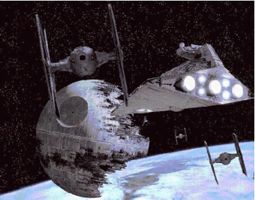 |
Activity is the key word for this competition, with the goal being for each team to achieve the desired result as quickly as possible. The situation is designed to reward teamwork and common sense thinking as well as knowledge of physics and the ability to work with formulae. Every team will come away with smiles and good memories regardless of how well they master the particular challenge. |
Event 5: Order-of-Magnitude Quiz (also known as Fermi Questions)
Arrive at a reasonable approximation for the value of a complex situation with very little to no information available to directly compute the answer. In this quiz, the contestants will need to quickly make assumptions for values to use in simple calculations in order to arrive at the "correct" answer, stated as the power of ten of the number that fits the accepted value.
Teams will receive 7 questions to complete within 15 minutes. The teams can divide the work in any way they see fit, but only one answer per question per team will be accepted.
Answers will be judged according to how many orders of magnitude the team's answer is from the judge's solution. The lowest score wins -- 0 points awarded for the answer accepted by the panel of judges, with 1 point scored per order of magnitude from the accepted value.
Examples of Order-of-Magnitude Quiz questions include:
- How many electrons enter the starter motor when a new, full-sized pickup starts?
- How many times would a tire of a Ford Taurus rotate when driven from NYC to LA?
- Estimate the number of gallons of gasoline used annually by all the cars in the USA.
A community of faculty, staff, and students engaged in better understanding the physical world.
Some of the links on this page may require additional software to view.


